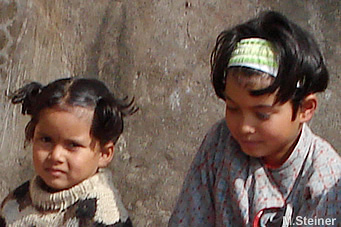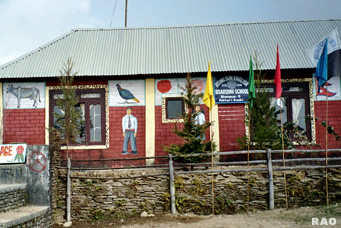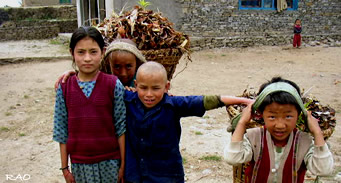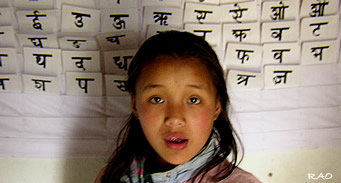|
Education
in Nepal: Reports
|
 |
Nepal EDUCATION |
|
|
 |
|
Training
the teachers keeps children in school
|
 |
BARDIYA,
7 July 2008 (IRIN)
For
sixth-grade student Srijana Biswakarma, school was a daily torment of being
humiliated by her teacher in front of her 40 classmates. He often criticised
the 15-year-old student for lagging behind the others, calling her a loser.
Her
studies deteriorated and she eventually dropped out. "I decided to drop
out of school and stay at home. I couldn't bear it anymore," Biswakarma
told IRIN in the village of Tapri in Bardiya District, nearly 700km southwest
of the capital Kathmandu.
She
is not alone.
"In
villages, children often quit school due to the negative attitude of their
teachers," said Lalumaya Gurung, Biswakarma's psycho-social counsellor,
who convinced her to return to school.
Gurung
also counselled the teacher for several weeks; he eventually changed his
behaviour after realising what a negative effect he was having on students.
 |
| There
are more than 21,000 public primary schools in Nepal - most of them in
rural areas - serving nearly 3.4 million children, according to the Department
of Education. The teacher to student ratio is one to 40, with only 12 percent
women.
The
government's National Planning Commission estimates that nearly 89 percent
of children (nearly 6.5 million) between five and 14 years old are enrolled
in school (grades 1-10) but that dropout rates remain high. |
|
According
to Child Workers in Nepal (CWIN), a national NGO, the dropout rate at primary
level is more than 40 percent, due to poverty, lack of teachers and poorly
managed schools.
Corporal
punishment
Corporal
punishment, which includes physical and psychological abuse, was a contributing
factor to dropout rates, according to the Centre for Victims of Torture
(CVICT), an NGO specialising in the psycho-social treatment of victims
of conflict, rape, sexual abuse and torture as well as corporal punishment
in schools.
CVICT
says the dropout problem due to corporal punishment is particularly pronounced
in rural public schools where teachers are often frustrated and suffer
from low morale, low salaries and crowded classrooms. On average, the ratio
is one teacher for every 50 students - 100 in many rural villages.
Male
teachers use corporal punishment, which causes many students to quit school
and undermines their learning ability, she explained. At the same time,
government plans to recruit more female teachers to government primary
schools have yet to be implemented, she added.
"Many
teachers, especially in the villages, need counselling," said Gurung, who
has trained several schoolteachers in the district.
| Teacher
training |
 |
 |
| CVICT,
with the support of Save the Children (Norway), has helped to train local
social workers including Gurung in community-based psycho-social training;
they in return counsel and train local teachers.
"It
has made a lot of difference, especially for teachers like us who have
to also deal with mentally disturbed children due to the armed conflict;
violence in the home, and their impoverished conditions," said Himalaya
Prasad Adhikari, a secondary school teacher, who was also trained in psycho-social
counseling. |
|
During
the training, the teachers are taught how to analyse the children's problems,
pinpoint their reasons for dropping out and how to motivate them to return
to school.
Teachers
trained in psychosocial counseling helping to retain children in schoolsAdhikari
explained that thousands of teachers trained by CVICT counsellors were
able to create better environments in schools and were successful in reducing
rate of school dropout in villages.
"Due
to the psycho-social training, the teachers have helped to keep a lot of
children in schools. The students are also performing better in their class,"
said Dil Maya Biswakarma, a local community schoolteacher working in Gangabasti
village of Bardiya district.
Over
the past two to three years, nearly 1,246 school teachers have been trained
in several districts of the western region's rural areas.
"Now
we listen to students patiently. I never used to pay attention to their
problems before the training," said teacher Anil Srivastava of the Sri
Gayatri Primary School in Tapri.
He
said many of his pupils had been affected by the conflict, which ended
in 2006; domestic violence and food insecurity. Several students had been
orphaned after their parents were killed or disappeared during the conflict
period.
"We
have changed as teachers due to the psycho-social care training. Now children
no longer fear to come to us," said teacher Bijaya Ghimire, explaining
that a lack of tolerance on the part of teachers towards their students
often undermined their learning abilities.
Credit
IRIN 2008
Copyright
Ⓒ UN Office for the Coordination of Humanitarian Affairs 2008
[
This report does not necessarily reflect the views of the United Nations]
Integrated
Regional Information Networks (IRIN), part of the UN Office for the Coordination
of Humanitarian Affairs (OCHA). |
 |
top
| more information
|
 |
| Links |
 |
|







